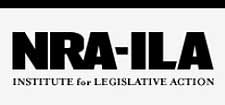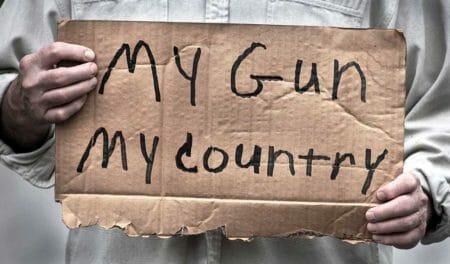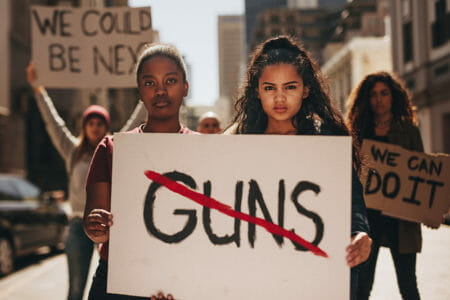
U.S.A. -(AmmoLand.com)- Social science methods are not perfect, but that has never stopped anti-gun researchers from making outlandish claims. Most recently, a team of researchers led by Doctor Apurva Bhatt from the University of Missouri Kansas City sought to evaluate the effect of changes in Missouri firearms laws on suicides among teenagers and young adults. Their analysis is burdened by a fundamental disregard of applicable firearms laws and their findings are so suspect that even uninvolved anti-gun researchers have formally acknowledged the problems.
Let’s begin with the results as claimed by the researchers in the first-page summary of their findings:
“Repeal of the PTP [permit to purchase] law was associated with a 21.8% increase in firearm suicide rates in young adults aged 19 to 24 years in Missouri. Lowering the minimum age of concealed carry to 19 years in Missouri was associated with a 32.0% increase in firearm suicide rates and a 29.7% increase in nonfirearm suicide rates in adolescents aged 14 to 18 years, and a 7.2% increase in firearm suicide rates in young adults aged 19 to 24 years.”
We’ll unpack these findings a bit but – spoiler alert – they didn’t include all of their results in that summary. Surely it was a simple oversight, but we’ll get to these other findings.
Bhatt and company here claim that the 2007 repeal of the requirement that a law-abiding adult obtain a permit to purchase a firearm is associated with a large increase in firearm suicide rates among people between the ages of 19 and 24. This, on the surface, aligns with what anti-gun activists and researchers insist must be true: that less onerous requirements to obtain firearms must lead to more deaths involving a firearm. The key to this study is what Bhatt and team have intentionally excluded from this summary. You see, according to the researchers in Kansas City, the repeal of this law is also estimated with a decrease in firearms-involved suicides among teenagers aged 14 to 18. If the law were really related to the suicide rate, one would expect similar changes among both populations.
But don’t take it from us. Take it from widely published researcher and new CDC grant recipient Doctor Ali Rowhani-Rahbar. He said, “This finding should be interpreted with caution, especially considering the lack of traditional measures of uncertainty when using the synthetic control approach. If not explained entirely by chance, one would want to understand why the consequences of repealing the PTP law might be qualitatively in different directions for individuals aged 14 to 18 years compared with those aged 19 to 24 years. This repeal does not seem to coincide with additional safety measures at home for families with youth, questioning the mechanism behind these seemingly opposing associations.”
Like, Dr. Rowhani-Rahbar, we’ll also question that mechanism. Bahr and company used a synthetic control methodology which, in short, means they used a statistical analysis program to build a version of Missouri comprised of other states with similar laws and other similarities across a very limited number of additional variables. The “synthetic” version of Missouri used to model teenage firearm suicides was 46% New York.
The second aspect of this new study concerns the twice-lowered age threshold for concealed carry permits in Missouri. The age requirement was lowered from 23 to 21 years old in 2011 and later lowered to 19 years old in 2014. According to the researchers, lowering the age for concealed carry permits to 21 is associated with a decrease in the firearm suicide rate among teenagers aged 14 to 18 AND among adults aged 19 to 24. This reduction is also associated with a decrease in the non-firearm suicide rate in the older of these two populations but an increase in the non-firearm rate among the younger cohort. Again, differing affects by age cohort.
Don’t remember reading these in the results summary? Of course not. The researchers left it out. Instead, they only mentioned the findings from the second age reduction. Supposedly, reducing the age for obtaining a concealed carry permit to 19 years old is associated with a 32% increase in the firearm suicide rate among teenagers 14 to 18 and a 7% increase in firearm suicide rate among adults aged 19 to 24. According to their analysis, this reduction is also associated with a nearly 30% increase in the non-firearm suicide rate among teenagers in Missouri but a 19% decrease in non-firearm suicide rate among adults age 19 to 24.
That…just does not make sense. Suicide prevention researchers believe that changing access to one type of means for suicide would also have a corresponding effect on other types of suicide. The overly simplified version of this would be an increase in non-firearm suicide if all firearms just disappeared. But for the third time in this study, the researchers have effects moving in opposing directions for the two age groups. If the change in the law was associated with changes in the suicide rate in the real world, we would expect to see offsetting changes between firearm and non-firearm suicide rates. That is not present in this study, so we have some questions about this mechanism as well. Maybe their data and coding system is flawed?
Missouri instituted permitless carry at the very tail-end of the researchers’ study period (in 2016), so they could maybe – maybe – be excused for not addressing that in their analysis IF one was desperate to believe in this work. They could have just excluded those years from their study period. What cannot be excused is the glaring oversight in the concealed carry laws in the states used to create the synthetic Missouri for these models.
“For the concealed carry analysis, states were only included in the donor pool if they had an existing concealed carry law and no change in that law during the study period (January 2008 to December 2018).”
States used to build “synthetic” Missouri included Alaska (2003), Arizona (2010), Arkansas (2013), Kansas (2015), Maine (2015), Mississippi (2013), New Hampshire (2017), West Virginia (2016), and Wyoming (2011).
The years in parentheses are the year in which each of these states enacted permitless carry. Some of these states set the age threshold for permitless carry at 18, some at 21. The point is that there is a very fundamental mistreatment of the states and laws at the heart of this analysis. Their “synthetic” Missouri also includes may-issue states that allow local official to deny even a qualified person a permit for arbitrary reasons. California, Hawaii, Massachusetts, New York, and New Jersey are all may-issue states that were used in the concealed carry permit model to build a synthetic Missouri.
The authors do not appear to have built a reliable “synthetic” Missouri. The charts on page 7 of their study reveal that synthetic Missouri and “real” Missouri did not have similar rates of firearm suicide or non-firearm suicide. The trend lines for the two Missouris are plotted on the same chart, and one can simply see that the two lines do not match up before the law was changed. This, of course, indicates that their synthetic control is not really approximate the relevant characteristics of Missouri.
There was no effort to control for mental health treatment or other laws or state programs that may have impacted suicide rates. The researchers offer ham-handed excuses for the discrepancies within their findings and the limitations of their study, and Rowhani-Rahbar tries to make the case that this “research” is still relevant and important because it contributes to the body of knowledge about firearm policies and suicide.
It does not contribute to the body of knowledge – it muddies what is known about suicide and firearms policy by promoting claims drawn from fatally flawed analyses.
This paper, like other examples of poorly done research – see here and here, seems to have prioritized blaming firearms instead of using a sound methodology.
About NRA-ILA:
Established in 1975, the Institute for Legislative Action (ILA) is the “lobbying” arm of the National Rifle Association of America. ILA is responsible for preserving the right of all law-abiding individuals in the legislative, political, and legal arenas, to purchase, possess, and use firearms for legitimate purposes as guaranteed by the Second Amendment to the U.S. Constitution. Visit: www.nra.org





